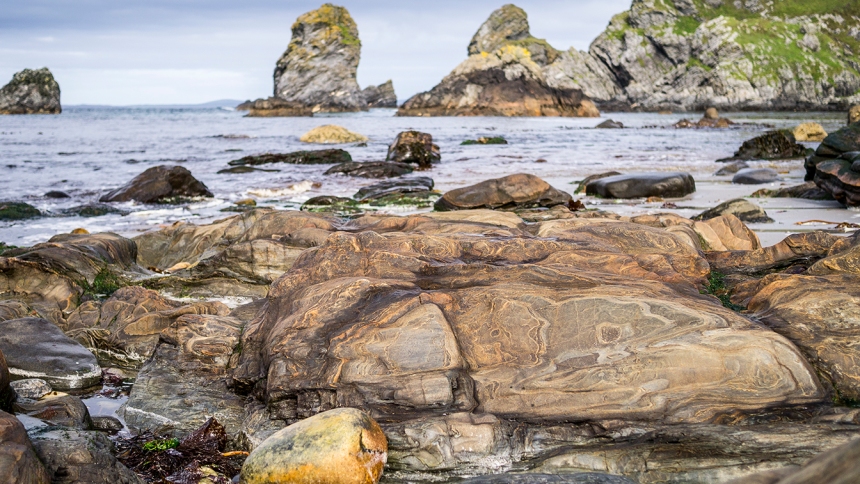
Killeyan beach is one of my favourite Islay spots, and last year it was also the location in which we photographed one of my all-time favourite designs – the Oa hoody.

Killeyan’s spectacular rock stacks and formations overlook the sea. It is a wonderful place for a solitary wander with only the occasional wild goat for company.

But almost a century ago, this quiet Islay shoreline was the scene of a terrible disaster, which is being commemorated with a wreath-laying ceremony in Islay today.
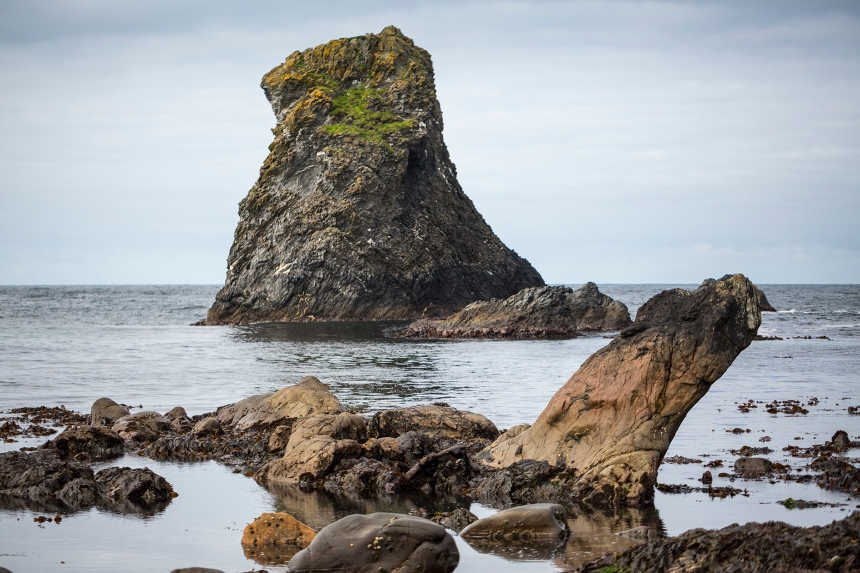
The Tuscania was an Anchor Line vessel, whose usual service was to carry passengers between Glasgow and New York. But on January 27th, 1918, The Tuscania set sail from Hoboken, New Jersey with over a thousand US troops on board – young men who had been sent to fight in the battlefields of Europe.
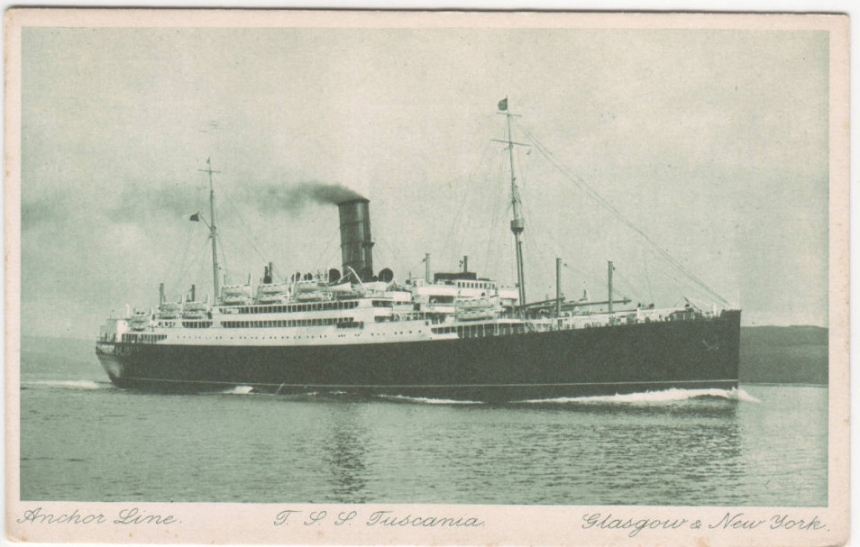
The Tuscania journeyed up the eastern seaboard to Halifax, where it was joined by other troop transporters to travel in convoy across the Atlantic. On February 5th, land was finally sighted, and identified as Islay. Passing through the North Channel dividing Islay and Rathlin Island, the convoy was now well on course for Liverpool, its destination. But its progress had been tracked by UB-77, then patrolling the Hebridean coastline.
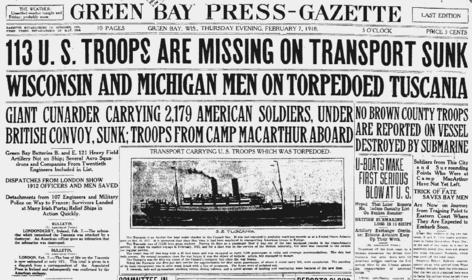
With the firing of the first torpedo, the Tuscania sank. Soldiers struggled to reach lifeboats which were in danger of being crushed by the listing ship. Some men were rescued by other vessels in the convoy, but many were cast adrift on the waves, just off the rocky shores of the Oa.

Over 200 young men were to lose their lives in the sinking of the Tuscania. This was the largest single loss of American life since the Civil War, and news of the disaster rocked the United States to its core. And for Islay, the impact of the sinking of the Tuscania was profound. Hundreds of young Islay men had already been lost to the war, and the disaster brought the conflict home to the island in the most terrible way imaginable. In the archive of The Museum of Islay Life are poignant memoirs, letters and albums which document the events of that awful night. Islay photographer, Archibald Cameron, recalled how a “shudder of horror went through the hearts of our fellow islanders as in the grey dawn of morning they found the shores strewn with the bodies of the unfortunate victims. The bodies were tenderly collected and every effort made to procure their identity. Large crowds gathered to pay their tribute of respect to the fallen, and after solemn services, the bodies were reverently laid to rest.”
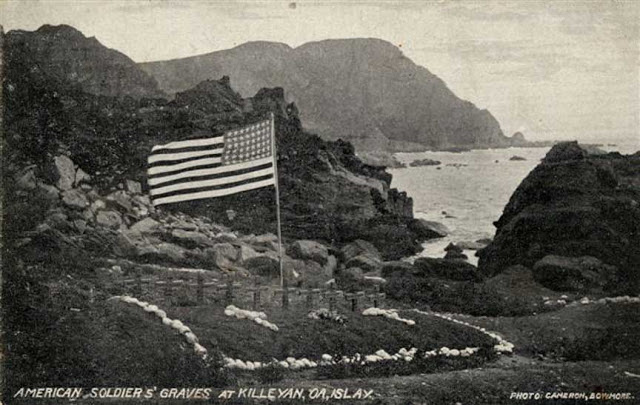
One location for the graves of the men lost in the disaster was at Killeyan.
The archive also includes moving accounts of the incredible efforts of Islay folk to save and care for the Tuscania’s survivors. Farmers Robert Morrison and Duncan Campbell spent the entire night of February 5th rescuing men from the treacherous cliffs and shores of the Oa, and were later awarded OBEs for their bravery. Mrs A Currie of Port Ellen looked after several survivors, and later received a letter of thanks from the governor of California, for the kindness she’d displayed: “I am told that you personally treated the boys with the same sympathy and tenderness that their own mother would have used.”
“The shock of the Great War has vibrated to the ends of the earth,” wrote Archibald Cameron in his photographic album commemorating the disaster, “and common suffering has made the whole world kin.”
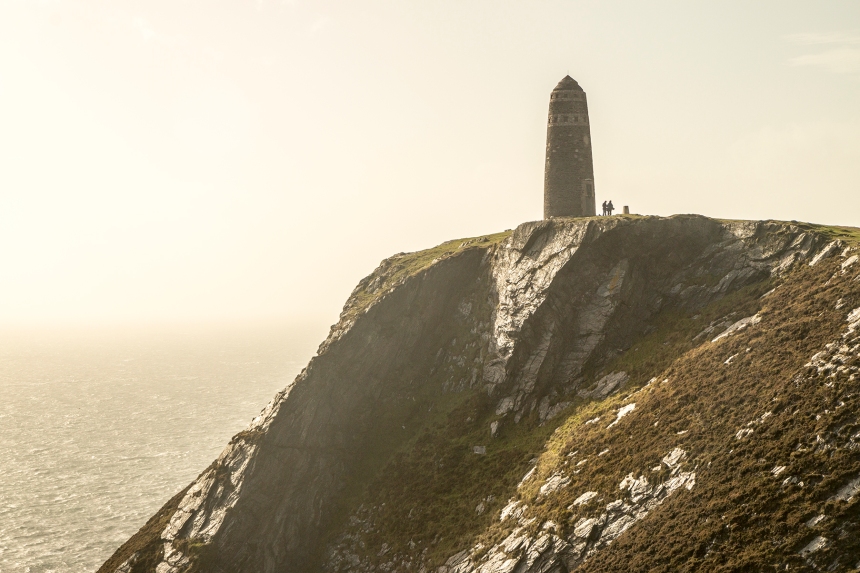
In 1920, the bodies of the dead were repatriated from Islay to the United States, and the American Red Cross erected a monument on The Oa to their memory.
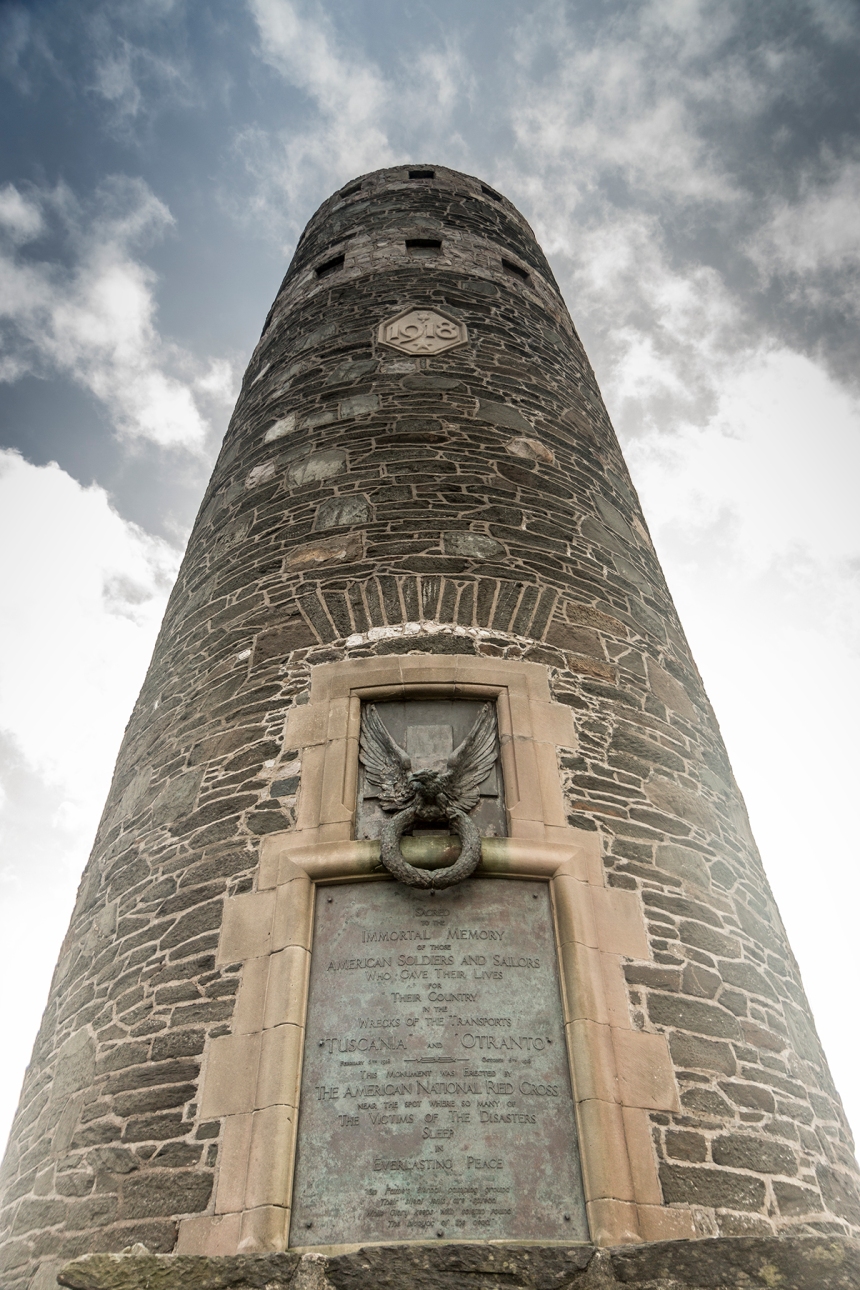
Standing on the cliff-face, high above the sea and overlooking the spot where the Tuscania sank (and where its wreck still lies), the monument has a hopeful beacon-like appearance. It can be seen from many spots in Islay, but its cliffside location rewards a walk, and some reflection upon the kinship and common suffering it represents.
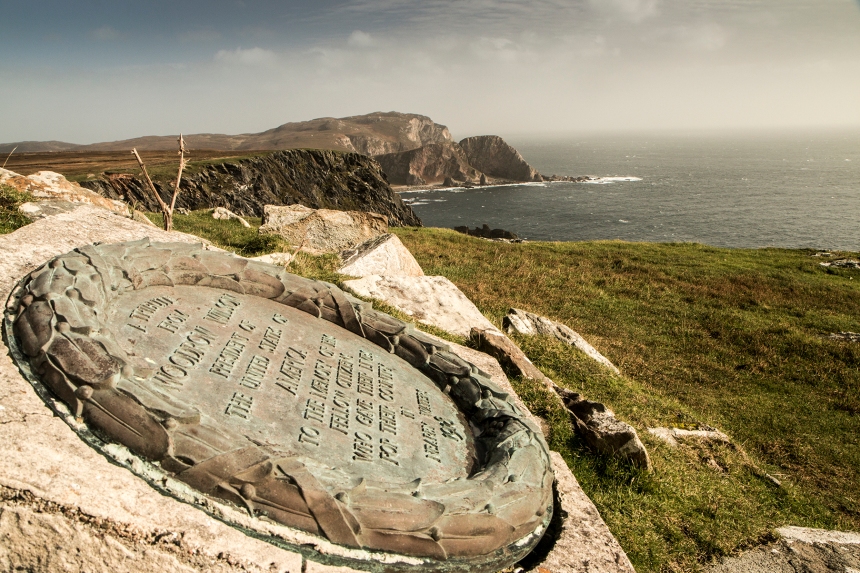
The plaque reads: “A tribute from Woodrow Wilson, President of the United States of America to the memory of his fellow citizens who gave their lives in nearby waters.”
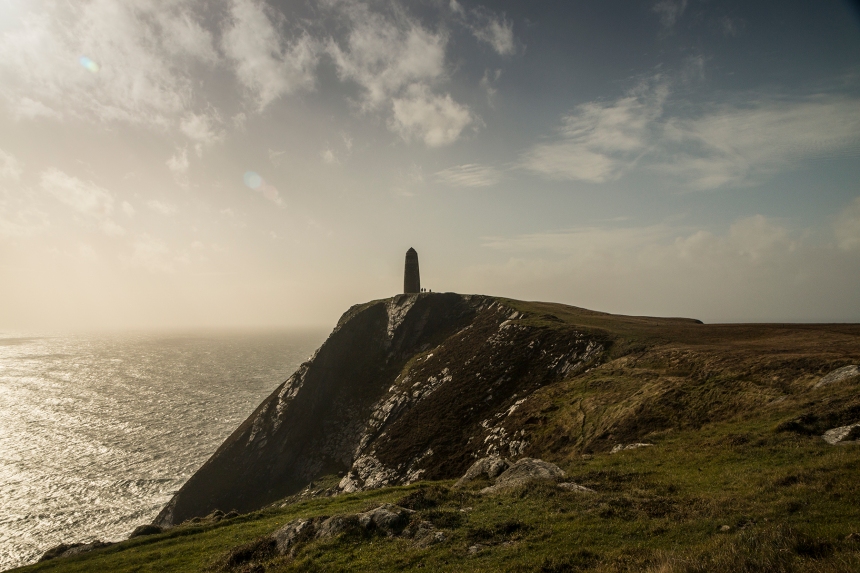
Tom shot these thought-provoking photographs around the Oa’s American Monument while we were working on our Islay book . . .
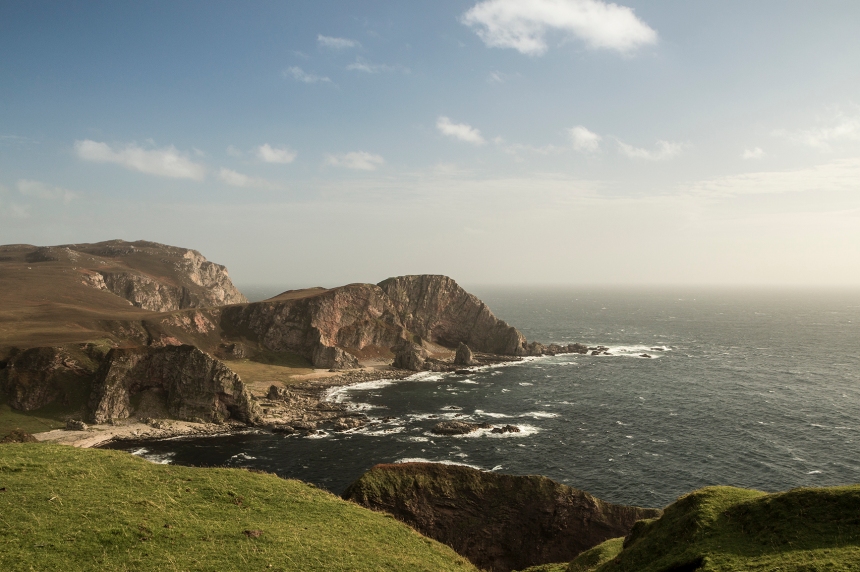
. . . and Les Wilson has just published a new book about Islay and the Tuscania, The Drowned and the Saved, which is now available from Birlinn Press.

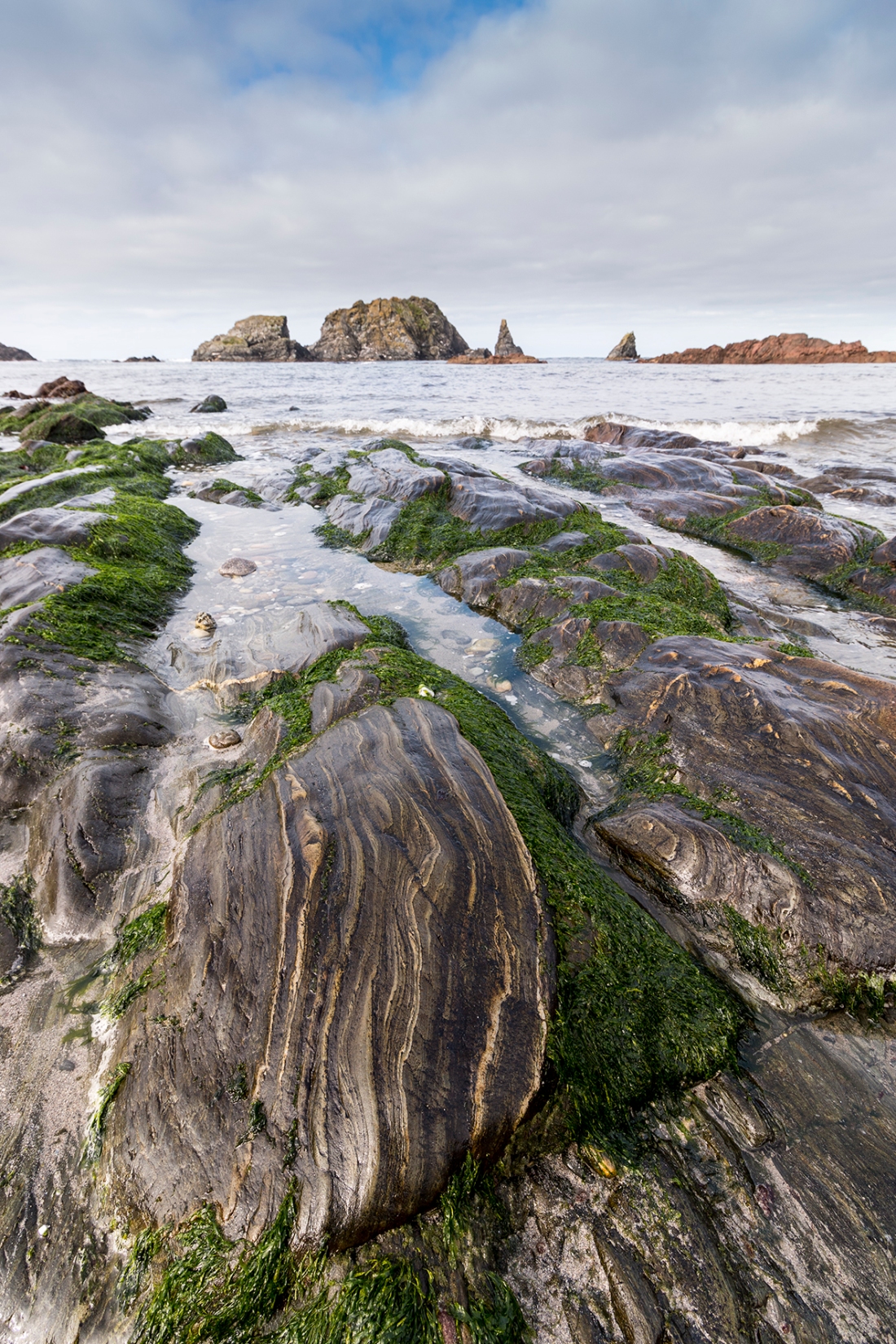
Thank you both for your beautiful essay and helping us remember and learn. Photographs are spectacular.
LikeLike
So very moving, and the comments too. Thank you.
LikeLike
Thank you for sharing this story and these pictures. Very moving.
LikeLike
Thank you Kate for sharing this sad story, and you, Tom forthe lovely pictures. They are both welcome tributes to the young soldiers and to the spirit of the people of Inlay. Sally from Wisconsin
LikeLike
Breathtaking photos! Thank you so much for sharing, what an inspiration!
LikeLike
Kate, your blog is a constant source of inspiration. Not only from the beautiful knitting patterns and breathtaking pictures, but also from your thoughtful historical content and personal insights. There is always something enlightened and refreshing to be found here. Thank you.
LikeLiked by 1 person
Kate, I’ve directed several family members to this post, for what are now obvious reasons: my grandfather’s having been there. My sister just wrote, “I have a letter in my files that Grandpa wrote home after he swam ashore… perhaps you’ve seen it? When I’m home again, I’ll find & scan it—”
I haven’t seen it, but am, of course, extremely interested. Grampa (which was what I called him) was both observant and articulate.
LikeLiked by 2 people
this is just such an incredible story Deb. If you’d ever like copies of these photos of Killeyan – where your Grampa must have swam ashore – just let me know.
LikeLike
Kate, when I get my sister’s scan of that letter, I’ll share it with you–and at that point, yes, I’d love to have some photos. Thanks to you and Tom.
Tears coming again–as I read more about what followed, I realize that–of course–even those who survived lost everything *except* their lives, and then needed to regroup and continue to the war they came to fight. And they did. For a while, this group thought they would be diverted to support the efforts to defend Paris. But their original assignment prevailed and they went farther south.
LikeLike
Thank you so much for sharing this, Kate and Tom. Your commentaries and photos always cause me to reflect.
LikeLike
My great-grandfather was 25 when he died on the first day of the Battle of the Somme—July 1,1916. He was fighting in an Irish regiment in the British army—the irony of that wasn’t lost on me when we’d visit my grandparents (his son was my grandfather) on the Falls Road in Belfast in the 1970s and 1980s, and the British soldiers would turn their guns on us kids for fun and laugh at their own ability to frighten children. War is always terrible.
LikeLike
Oh, my. I’m so sorry. They were so young: your grandfather, the children, even the cruel soldiers. As the song goes, “when will they ever learn?”
LikeLiked by 1 person
Oh, that brought back memories – one of my great-great uncles was one of the rescuers. The experience was so appalling he didn’t talk about it. His son found a letter he had written but never posted among his things when he died.
LikeLiked by 3 people
My God, what a world. The sorrow of war, indeed.
LikeLiked by 1 person
Another touching, well-written and well-photographed essay.
LikeLike
Thank you for sharing this story Kate. Thank you Tom for your spectacular photography. This incident had escaped my radar somehow.Now I will learn more.
Julie
LikeLike
I’d not heard of this before. Thank you for the beautiful essay; I am moved.
LikeLike
Thank you for the article and Tom for the photos. So moving! I would love to visit someday. The coastline there looks just like mine here in Maine, USA but such a deep history your land has!
LikeLike
I just go to pieces around anything to do with WWI. Thank you for ( I think someone else said this) your thoughtful and gentle rendering of such a tragic event. Beautiful photos.
LikeLike
Another beautiful and poignant post. I, too, had never heard of the Tuscania. I’m thinking that WWI was a war rather overlooked in my grade school education. I especially liked your observation about the monument being like a beacon.
LikeLike
c’est extraordinaire pour Deborah Robson de retrouver ainsi les traces de sa famille a travers un blog de tricots/laines ecossais, c est tres emouvant ….et les photos de Mr. Tom sont superbes.
WOuld you excuse my french language, I cant write well your
LikeLiked by 2 people
Je vous remercie pour votre commentaire, goerger. Je suis absolument d’accord!
LikeLike
Oh! vous parlez francais!…c etait en 1918 et deja, ces jeunes gens venaient a notre secours…
19 ans, et aller a la guerre. Ne remerciez pas, Deborah
LikeLiked by 1 person
Je voudrais vous montrer une photo de mon grand-père, mais je ne suis pas sûr que ce soit possible! J’ai lu un livre sur le naufrage du Tuscania et sur le travail de sa compagnie en France. Il y avait beaucoup de grâce et de courage dans ce qu’ils ont fait.
[For the English-speaking among us: I would like to show you a photo of my grandfather, but I’m not sure it’s possible. I’ve read a book about the sinking of the Tuscania and about the work my grandfather’s company [not sure this is the right word for his battalion] did in France. There was a lot of grace and courage in what they did.]
LikeLiked by 1 person
Oui oui…quel travail (?) effectuait il en France? où? c est fou d y repenser. Etait il marié avant de partir? mon grand père était dans le Nord à Douai en 1918 et a pu revenir vivant de la guerre dans les tranchées.nicole
LikeLiked by 1 person
Il est intéressant de penser aux expériences des survivants à la suite du naufrage de Tuscania et de l’énorme perte de vie qui l’accompagne. Mon grand-père était, étrangement, un bûcheron pendant la guerre, et il était à l’autre bout de la France de votre grand-père.
Après que les survivants aient été rassemblés, «nous sommes partis pour Winchester, en Angleterre, où nous étions stationnés cinq semaines. . . . Beaucoup d’hommes étaient vêtus d’uniformes de marins britanniques, d’uniformes de soldats britanniques et même de vêtements civils. Finalement nous avons été rendus présentables assez et avons été autorisés à naviguer pour la France et prendre notre place si longtemps nous attendant.» (De l’histoire des vingtièmes ingénieurs.)
Le 23 mars 1918, ils ont voyagé de Southampton au Havre. Ils ont été chargés d’exploiter des scieries à Castets, dans le sud-ouest de la France, sous l’égide du British Forestry Service. Après l’Armistice le 11 novembre 1918, ils s’installent à Labrit puis à Captieux, près de Castets, et y exploitent des scieries pendant six mois supplémentaires, retournant aux États-Unis à la fin de mai 1919.
Mon grand-père a rencontré ma grand-mère au Minnesota (elle est norvégienne) et ils se sont mariés en 1921.
[And the English:]
It’s interesting to think of what happened to the survivors in the aftermath of the Tuscania’s sinking and the accompanying enormous loss of life. My grandfather was, oddly enough, a lumberjack during the war, and he was at the other end of France from your grandfather.
After the survivors were gathered up, “we left for Winchester, England, where we were stationed five weeks. . . . Many of the men were dressed in British sailors’ uniforms, British soldiers’ uniforms and even civilian clothes. Finally we were made presentable enough and were permitted to sail for France and take our place so long waiting for us.” (From the history of the Twentieth Engineers.)
On March 23, 1918, they traveled from Southampton to Le Havre. They were assigned to operate sawmills at Castets, in the southwest of France, under the British Forestry Service. Following Armistice on November 11, 1918, they moved to Labrit and then to Captieux, both not far from Castets, and operated sawmills there for an additional six months, returning to the U.S. at the end of May 1919.
My grandfather met my grandmother in Minnesota (she’s Norwegian) in 1921.
LikeLike
Pardon the infelicities in my French. . . . I have not had much opportunity to use the language in about fifty years! It’s a pleasure to dust it off.
LikeLike
And thanks from me too. Letting us into the breadth of your interests, passions and concerns is a tonic in all possible ways. I just keep remembering the criticism of you modelling your own designs and, whilst I understand where that writer is coming from perhaps in the sense that her or his life may be a world apart, I totally relish you being you.
LikeLiked by 2 people
Thank you for this. I’ve always been a history nut, but only recently I have started exploring the great wars.
LikeLike
Wow, Kate. This blindsided me this morning as I sat down to work.
My grandfather (maternal) served with the U.S. Army, 6th Batt., 20th Engineers, Co. E. Forestry Dept., and was on the Tuscania when it was torpedoed. Obviously, he survived–I’m here. He was born February 11, 1899, and the Tuscania went down January 27, 1918, so he was two weeks shy of his 19th birthday. He went on to work in France on war-related construction projects.
I would love to have been able to be at the wreath-laying ceremony commemorating his lost shipmates–and his own experience, which no, he didn’t talk about.
LikeLiked by 2 people
So yeah, I’m starting my workday with tears in my eyes. The photos are lovely, but I’m going to have to come back and look at them later when they’re not blurry.
LikeLike
Wow, Deb – how extraordinary – what an experience for him at 19…what a life he must have had.
LikeLiked by 1 person
This side of the family also lost everything in the Depression–blew out of the Oklahoma dust bowl. Yes, a lot of history there. And a lot of durability.
LikeLiked by 1 person
Sorry–got the date of the sinking wrong in my comment above (noted sailing, rather than sinking). Just overwhelmed. I’ve ordered the new book.
LikeLike
Hello Deborah ! Le site où travaillait votre grand’pére etait un triangle en-dessous de Bordeaux, la Gascogne, une trés grande et belle for^et Les Landes, proche de l’Espagne et des Pyrennees. Mais ce qui est curieux, c est que ce soit le British Forestry Service qui l ait envoye travailler dans des scieries…..françaises ? avant de le rapatrier aux USA, 6mois plus tard.
Oui, votre francais est impeccable…
LikeLiked by 1 person
Et hello Nicole! Je suis d’accord que c’est curieux. Si je comprends bien, le British Forestry Service a coordonné les travaux forestiers en Castets, Labrit, et Captieux. Selon les descriptions que j’ai lues, je pense que les scieries ont été fabriquées au Canada. C’était une entreprise internationale coopérative. Au cours des six derniers mois, on s’est moqué de la façon dont le bataillon allait devoir construire les navires sur lesquels les hommes allaient retourner aux États-Unis.
[I agree that it’s curious. If I understand correctly, the British Forestry Service coordinated the forestry work in Castets, Labrit, and Captieux. According to the descriptions I’ve read, I think the sawmills themselves were made in Canada. It was quite the cooperative international venture. During the final six months, there was some joking that the troops were going to have to build the ships they would return to the U.S. on.]
LikeLike
Thank you for remembering, Kate and Tom. I have read of this tragedy and Scotland’s beautiful response before. Your sensitive memorial brings tears to my eyes.
LikeLiked by 1 person
Sadly this is one of the many stories of World War I which I had never known. Thank you for your thoughtful and gentle way of sharing the tragedy of these brave young solders, and the courageous love shown then by the people of Islay. Tom’s photographs are a moving tribute to this part of your world.
LikeLiked by 2 people
Thank you from an American xo
LikeLiked by 2 people
I strongly share the exact same sentiments as The Other Kristen wrote. I am sad to say I have never heard the story of the Tuscania and it’s men. I will now search the library to see what more I can learn about it. I am a 72 year old Michigan woman who currently lives near Lake Michigan with Wisconsin being on the other side of the Lake, so the picture you show of the Green Bay Gazette especially caught my eye. Thanks so much to both you and Tom for sharing so much history with us both in your writing and photos. My children’s paternal grandparents were born and raised in Scotland before they came to the United States as adults by way of Canada. I enjoy reading and seeing what you write about my childrens heritage and share it with them..
LikeLiked by 6 people
You made me cry. For the “boys” lost on that dreadful night. For the “boys” of Islay, dead in Flanders Fields. Even for the crew of the U-boat, who were as caught in the spider’s web of horror as any Allied troops and who, if they had not already suffered, would suffer with the horror that Germany would become.
And today, I knit my projects – some of British yarn- with Addis from Germany, KAs from Japan, and Signatures from the US. Oh, dear God, I pray that the people of the world could knit their friendship up, so that no more “boys” (or “girls”) must ever have their lives so wasted, even if their lives are remembered.
LikeLiked by 10 people
Oh yes…so many people struggle with the notion that we are one species on one planet and that we get one shot at life…how about we start being a bit kinder to each other…? Knitting may indeed help!
LikeLike
An amazing piece of history that was unknown to me as an American. Thank you for the beautiful tribute.
LikeLiked by 1 person
What wonderful photographs and such a lovely tribute. The rocks are particularly beautiful.Thank you for sharing this story.
LikeLike
Thank you for the lovely tribute. You are both such artists!
LikeLiked by 1 person
Thank you, Kate. As an American who believes that I am watching our country unravel, your post and the story of this tragedy has moved me deeply. I fear that the U.S. has lost the goodwill of its long-valued allies, and that it will take many decades (if we are lucky) for us once again to be proud of our country’s policies, both foreign and domestic. I know that this comment will be seen by some as unnecessarily political, but I am the sister, daughter, and granddaughter of US war veterans (WWII, Korea, Desert Storm), and I cannot envision any of those men — each far from perfect — being proud of what the US is becoming
LikeLiked by 6 people
Hear, hear.
LikeLike
Thanks for sharing this Kate. I was reading about this, and other WWI sea disasters involving Us Troops, only a few weeks ago. For all the WWI Remembrances, there are still so many,many more tragedies that we scarcely hear or know about. It’s hard to hold together the beauty of the land/seascape and the horrors that surround and inhabit them.
LikeLiked by 1 person
Thank you for helping us all remember and not forget.
LikeLiked by 1 person
Auhh Kate..thank you for this bit of history, previously unknown to me..it touched my heart, another piece of the sadness of war..Tom your photography allows us to share in the history , and the places you live and love..I want to catch the first plane out and sit on a Scottish cliff by the ocean and knit..so happy for you both that your life is at this stage and that you have each other, and Bruce….hugs pat j
LikeLiked by 2 people
Big hugs to you too, Pat, from Scotland x
LikeLike
Thank you so much for doing what you do to share your unique lives and energies with us. We are extremely lucky to have you!
LikeLiked by 1 person
Thank you Kate and Tom. Such beautiful scenery on a sunny day but must have been a scene of hell that night.
Kate, you always make me think. Thank you
LikeLiked by 1 person
Thank you, again, Kate, for so beautifully sharing in words (and illustrating with Tom’s lovely photos) both a wonderful piece of Scotland, and the unnecessary sadness and misery that war brings.
LikeLiked by 1 person